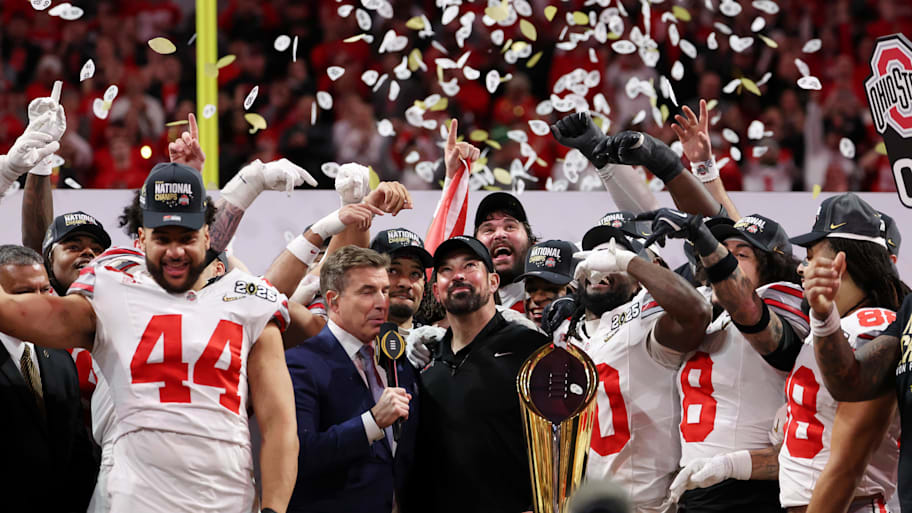
The 2025 College Football Playoff will kick off on Friday, Dec. 19 with the first of four opening-round playoff games to be held at the higher seeds’ on-campus stadiums. The 2024 season marked the first expansion of the playoff from four teams to 12, opening up what has historically been a restrictive postseason system to one that gives access to most of the sport, even one lucky participant from the smaller Group of 5 leagues.
Change has been a constant in college football, and the CFP didn’t even make its debut until a decade ago, long after the NCAA tournament allowed college basketball to dominate all of late-March. College football has the end of the NFL season to contend with, but so far, the sport is better off for the shift away from the bowl and poll-dominated systems and formats, which led to serious dissatisfaction among fans and many of the players and coaches who didn’t have the chance to prove themselves on the field. Debates about which teams should reach the playoff continue, but the decades of split national championships are behind us.
As we near the second year of the 12-team playoff, let’s take a look at how the event has evolved, the formats that came ahead of the CFP and what may lie ahead of the sport.
The College Football Playoff debuts with four-team format in 2014
After decades of debate over how college football should crown a national champion, and the up-and-down 15 years of the BCS, the sport finally adopted a true playoff system ahead of the 2014 season.
With the playoff replacing the poll-based BCS, the sport completely changed how the teams are selected for the event as well. A 13-person selection committee, made up of current and former athletic directors, as well as former coaches, players, media members and other relevant administrators comprised the committee, which includes at least one active athletic director from each of the Power 5 (now the Power 4) conferences.
The committee begins meeting at midseason, releasing their own Top 25 rankings each week through the end of the conference championship games. On the Sunday after the conference title games, it releases its final batch of rankings, including the CFP field.
In the four-team era, the playoff participants were all at-large teams, and there were no automatic bid for conference champions. This resulted in at least one of the Power 5 conferences being left out each season.
Every College Football Playoff field in the four-team era
*Bold indicates that season’s national champion, italics indicate the national runner-up.
Adopting the first playoff was a true slog. Once the sport broke down the barriers preventing the playoff, expansion has proven far less arduous. After just a decade of four-team playoffs, the CFP’s board of managers—a governing body comprised of university presidents and chancellors—voted to expand the field to 12 by 2026, ultimately moving up the timeline in time for the ‘24 season.
The CFP expands to 12 teams after a decade
The expansion brought more accessibility to the sport, with every single FBS program (aside from those in their transition periods up from FCS) technically having a chance to make the field. At the time of the vote, the format called for the six highest-ranking conference champions to receiving automatic bids, with the four highest-ranking teams of those champions to earn first-round byes. The other six spots were granted to the highest-ranking at-large teams.
Of course, arguably the most impactful wave of conference realignment struck at the same time as playoff expansion, and by the time play was set to begin in 2024, one of the Power 5 leagues—the Pac-12—had effectively collapsed, with the Big Ten siphoning off UCLA and USC and later Oregon and Washington. The move led Arizona, Arizona State, Colorado and Utah to flee to the Big 12 and Cal and Stanford to form an awkward alliance with the ACC. The CFP quickly shifted to a “five plus seven” model: the five highest-ranked conference champions with automatic bids, and seven at-large teams. The other big change from all previous postseason systems: the first round of the playoff featuring the teams seeded five through 12 would be hosted at the higher seeds’ home stadiums.
The 2024 playoff field quickly revealed how the unique format could leave top programs on the outside looking in. Big Ten champion Oregon and SEC champion Georgia claimed the top two seeds and byes, but the other two byes went to Mountain West champion Boise State, a 12–1 club with a close loss to the Ducks, and Arizona State, a team that came out of nowhere to win the Big 12 at 11–2. With the format, the ninth-ranked Broncos earned the No. 3 seed and 12th-ranked Sun Devils were placed at No. 4. Additionally, Clemson bounced back from a disappointing start to the season to sneak into the ACC champion and took down SMU to earn the fifth automatic bid despite finishing ranked No. 16, costing No. 11 Alabama a spot in the field.
Ohio State was 10–2 entering the postseason, having missed out on the Big Ten championship game, and ending the season with a stunning loss to Michigan. In the four-team era, they would have been two spots outside of the field after being ranked sixth in the final selection committee Top 25. They wound up seeded eighth in the 12-team field, and caught absolute fire, beating Tennessee, top-ranked Oregon, Texas and Notre Dame by an average of 17.5 points to capture the national championship.
By the end of the playoff, there was little doubt that Ohio State was the nation’s best team, but in no previous format would the Buckeyes have come close to competing for a national championship.
The 2025 edition of the playoff is just over a month away and will feature further tweaks. Gone are the automatic byes for conference champions; now, the top-four ranked teams will receive byes to the quarterfinal round. Five automatic bids will still be awarded to the highest-ranked conference champions. As we saw with the first rankings release, if there are not five conference champions ranked in the Top 25, the selection committee will continue the ranking exercise until a fifth conference champion is selected.
Future College Football Playoff expansion
Of course, as the first few iterations of the CFP have been successful, the powers that be—namely, the Big Ten and SEC and their main media partners, Fox and ESPN—are pushing further expansion.
As reported by Sports Illustrated’s Bryan Fischer, most of the sport, including the SEC, favors a 16-team model while maintaining the current five highest-ranked conference champions as automatic bids. The Big Ten, meanwhile is eyeing massive expansion to 24 or even 28 teams, and a revisited automatic bid structure that would heavily favor them and the SEC.
The deadline to expand the playoff in time for the 2026 season in Dec. 1, and as of now the two sides are at an impasse. Without an agreement by the end of November 2025, the 12-team playoff may be here to stay for the foreseeable future.
How was the college football national championship decided before the College Football Playoff?
1869 to 1935: Retroactive champions
College football has always been the Wild West to some extent. That is certainly true of the first 70-plus years of the sport’s history (minus the West part, at least, until the 1920s when Cal became a power).
Beginning with the split two-game series between New Jersey institutions Rutgers and Princeton until the Associated Press began releasing its Top 25 in 1936, the history of national championships was one largely determined long after the fact. To name the retroactive national champions from those years, the NCAA has leaned on historian polls led by the National Championship Foundation, Helms Athletic Foundation and College Football Researchers Association. Ivy League programs like Princeton and Yale dominated the late 1800s, while a modern power—Michigan—earned its first claimed national title in 1901, the earliest championship for any current FBS program outside of Rutgers’s 1869 split.
By the end of this era, the Ivy League’s reign was over, giving way to the programs who would go on to define the sport. After Yale (along with Illinois) were given claim to 1927 championships, Alabama, Georgia Tech, Minnesota, Notre Dame and USC were among the dominant programs to emerge.
1936 to 1992: The polls take over
Historians assigned national championships to try and give some shape to college football’s first seven-plus decades. While they’ve continued to do their work, they gave way to sportswriters in 1936, when the AP Top 25 debuted, declaring the official national champion each year.
Of course, this method still came down to the votes of very fallible humans, rather than anything being decided on the field. The AP was the only show in town from 1936 through 1949, a period that saw Notre Dame win four national titles (‘43, ‘46, ‘47, ‘49), Minnesota win three (‘36, ‘40, ‘41) and Army take home a pair (‘44, ‘45).
United Press International began to release the first coaches poll in 1950, while the Football Writers Association of America and National Football Foundation began releasing their own polls in the 1950s. The 50s began with four consecutive unanimous national champions until ‘54, when 10–0 Ohio State was awarded the national title by the AP, and 9–0 UCLA won the honor from the UPI and FWAA. The sport would see 13 instances of split national champions, including a pair of years in which three teams (Alabama, Arkansas, Notre Dame in 1964; Nebraska, Texas, Ohio State in 1970) claimed titles.
Colorado and Georgia Tech split the vote along AP/coaches poll lines in 1990 and Miami and Washington did the same the next year, with the back-to-back instances moving the needle enough to lead the sport to attempt to crown an official national champion through play on the field.

1992 to ‘97: The Bowl Coalition and Bowl Alliance begin the march towards modernity
As college football’s postseason has evolved, the fate of the bowl game has been of deep concern for those who have tried to halt progress. To their credit, the games have significant historical value and play a big part in their local communities. Even today, winning a bowl game is a strong marker of success for developing programs.
The Bowl Coalition, established in 1992, brought together four of the most prominent bowls—Orange, Sugar, Fiesta and Cotton—to forgo historic conference tie-ins when necessary to allow for a No. 1 vs. No. 2 national championship game. Of course, one key bowl was not involved: the Rose Bowl. “The Granddaddy of Them All” hung on to its well-established Big Ten vs. Pac-10 Championship format, creating an issue when one of those teams would otherwise be involved in the national title game. That came to fruition in 1994, with No. 1 Nebraska facing No. 3 Miami at the Orange Bowl, while undefeated No. 2 Penn State faced No. 12 Oregon in the Rose Bowl. Nebraska would win the national title, and because of the Bowl Coalition setup, Penn State had to settle for a Rose Bowl win and No. 2 final ranking, with no opportunity to compete with the Cornhuskers for the national title.
That season proved to be the end of the Bowl Coalition, but its successor, the Bowl Alliance, faced largely the same issue. The Fiesta, Orange and Sugar Bowls would rotate the opportunity to host the national championship game between the two top-ranked teams, but the Rose Bowl held firm on its Big Ten vs. Pac-10 matchup. The 1995–96 season finished with No. 1 vs. No. 2, as Nebraska took down Florida at the Fiesta Bowl, but once again Rose Bowl threw a wrench into the plans the following year, with No. 3 Florida beat No. 1 Florida State at the Sugar Bowl while No. 4 Ohio State beat No. 2 Arizona State at the Rose Bowl. 1997–98 once again featured a split national champion, with No. 1 Michigan beating No. 8 Washington State at the Rose Bowl, and No. 2 Nebraska defeating No. 3 Tennessee at the Orange Bowl for the Bowl Alliance national championship. The Coaches Poll would declare Nebraska as champion, but the AP went with Michigan.
1998 to 2013: The BCS ushers in college football’s computer age
After years of split titles and confusion stemming from the Rose Bowl’s holdout, the powers that be finally established a system with buy-in from all of the power conferences and prominent bowl games. The BCS originally comprised of the Fiesta, Orange, Rose and Sugar Bowls, with six spots in the games going to the champions of the ACC, Big East, Big Ten, Big 12, Pac-10 and SEC, and two more at-large spots. The system also guaranteed a matchup between No. 1 and No. 2, as decided by the BCS model, which included the AP and Coaches Poll as well as a host of computer polls, a strength of schedule calculation, a team’s losses and their quality wins.
The system was successful in pitting No. 1 vs. No. 2 and crowning a national championship from that matchup each year, and more often than not the matchup came without much controversy. However, there were a number of situations in which the limitations of a two-team championship became clear as day. The most glaring example was 2003, when USC was left out of the game in favor of LSU and Oklahoma, despite the Sooners’ blowout Big 12 championship loss to Kansas State. The Tigers would go on to win the national championship game, but the AP—which opted against binding its vote to the result of the BCS title game—awarded USC with the No. 1 ranking after its Rose Bowl win over Michigan.
The BCS system left a number of notable undefeated teams on the outside looking in, including Auburn, Boise State and Utah in 2004, the Utes again in ‘08 and TCU in 2010. Meanwhile, the lower divisions of college football had staged successful playoffs for years. Finally in June 2012, the BCS presidential oversight committee approved the change to the four-team playoff in time for the 2014 season.
More College Football on Sports Illustrated
Listen to SI’s new college sports podcast, Others Receiving Votes, below or on Apple and Spotify. Watch the show on SI’s YouTube channel.
This article was originally published on www.si.com as College Football Playoff Format History: How the Bracket Has Changed Over the Years.







